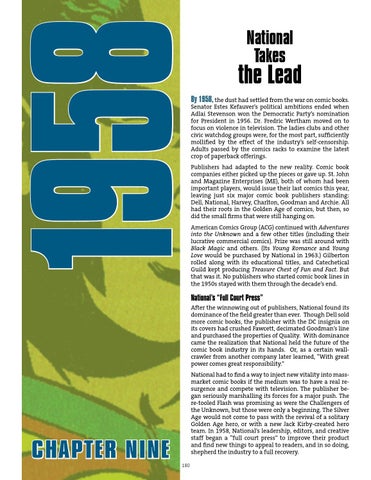1958
National Takes
the Lead
By 1958, the dust had settled from the war on comic books. Senator Estes Kefauver’s political ambitions ended when Adlai Stevenson won the Democratic Party’s nomination for President in 1956. Dr. Fredric Wertham moved on to focus on violence in television. The ladies clubs and other civic watchdog groups were, for the most part, sufficiently mollified by the effect of the industry’s self-censorship. Adults passed by the comics racks to examine the latest crop of paperback offerings. Publishers had adapted to the new reality. Comic book companies either picked up the pieces or gave up. St. John and Magazine Enterprises (ME), both of whom had been important players, would issue their last comics this year, leaving just six major comic book publishers standing: Dell, National, Harvey, Charlton, Goodman and Archie. All had their roots in the Golden Age of comics, but then, so did the small firms that were still hanging on. American Comics Group (ACG) continued with Adventures into the Unknown and a few other titles (including their lucrative commercial comics). Prize was still around with Black Magic and others. (Its Young Romance and Young Love would be purchased by National in 1963.) Gilberton rolled along with its educational titles, and Catechetical Guild kept producing Treasure Chest of Fun and Fact. But that was it. No publishers who started comic book lines in the 1950s stayed with them through the decade’s end.
National’s “Full Court Press” After the winnowing out of publishers, National found its dominance of the field greater than ever. Though Dell sold more comic books, the publisher with the DC insignia on its covers had crushed Fawcett, decimated Goodman’s line and purchased the properties of Quality. With dominance came the realization that National held the future of the comic book industry in its hands. Or, as a certain wallcrawler from another company later learned, “With great power comes great responsibility.” National had to find a way to inject new vitality into massmarket comic books if the medium was to have a real resurgence and compete with television. The publisher began seriously marshalling its forces for a major push. The re-tooled Flash was promising as were the Challengers of the Unknown, but those were only a beginning. The Silver Age would not come to pass with the revival of a solitary Golden Age hero, or with a new Jack Kirby-created hero team. In 1958, National’s leadership, editors, and creative staff began a “full court press” to improve their product and find new things to appeal to readers, and in so doing, shepherd the industry to a full recovery.
CHAPTER NINE 180
